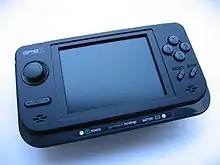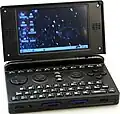Seventh generation of video game consoles
The seventh generation of home video game consoles began on November 22, 2005, with the release of Microsoft's Xbox 360 home console. This was followed by the release of Sony's PlayStation 3 on November 17, 2006, and Nintendo's Wii on November 19, 2006. Each new console introduced new technologies. The Xbox 360 offered games rendered natively at high-definition video (HD) resolutions, the PlayStation 3 offered HD movie playback via a built-in 3D Blu-ray Disc player, and the Wii focused on integrating controllers with movement sensors as well as joysticks.[1] Some Wii controllers could be moved about to control in-game actions, which enabled players to simulate real-world actions through movement during gameplay. By this generation, video game consoles had become an important part of the global IT infrastructure; it is estimated that video game consoles represented 25% of the world's general-purpose computational power in 2007.[2]
| Part of a series on the |
| History of video games |
|---|
Joining Nintendo in releasing motion devices and software, Sony Computer Entertainment released the PlayStation Move in September 2010, which featured motion-sensing gaming similar to that of the Wii. In November 2010, Microsoft released Kinect for use with the Xbox 360. Kinect did not use controllers, instead using cameras to capture the player's body motion and using that to direct gameplay, effectively making the players act as the "controllers". Having sold eight million units in its first 60 days on the market, Kinect claimed the Guinness World Record of being the "fastest selling consumer electronics device".[3][4]
Among handheld consoles, the seventh generation began somewhat earlier than the home consoles. November 2004 saw the introduction of the Nintendo DS,[5] and the PlayStation Portable (PSP) came out in December. The DS features a touch screen and built-in microphone, and supports wireless standards.[6] The PSP became the first handheld video game console to use an optical disc format as its primary storage media.[7][8] Sony also gave the PSP multimedia capability;[9] connectivity with the PlayStation 3, PlayStation 2, other PSPs; as well as Internet connectivity.[10][11] Despite high sales numbers for both consoles, PSP sales consistently lagged behind those of the DS.[12]
A crowdfunded console, the Ouya, received $8.5 million in preorders before launching in 2013. Post-launch sales were poor, and the device was a commercial failure. Additionally, microconsoles like Nvidia Shield Console, Amazon Fire TV, MOJO, Razer Switchblade, GamePop, GameStick, and more powerful PC-based Steam Machine consoles have attempted to compete in the video game console market; however they are seldom classified as "seventh generation" consoles.[13][14][15]
The seventh generation slowly began to wind down when Nintendo began cutting back on Wii production in the early 2010s. In 2014, Sony announced they were discontinuing the production of the PSP worldwide, and the release of new games for the DS eventually ceased by 2016. Microsoft announced in that same year that they would discontinue the Xbox 360. The following year, Sony announced that it would soon discontinue the PlayStation 3. Around that time, the remaining Wii consoles were discontinued, ending the generation as all hardware was discontinued. The final Xbox 360 physical games were released in 2018, as FIFA 19 and Just Dance 2019. Despite this, several more Wii games were released, including a few more annual Just Dance sequels,[16][17] as well as a limited 3,000-copy print run of a physical release of Retro City Rampage DX . The eighth generation had already begun in early 2011, with the release of the Nintendo 3DS.
Home video game consoles
Xbox 360
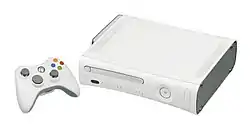
The Xbox 360 gained an early lead in terms of market share, largely due to its established Xbox Live online gaming system, and its early launch date, which was one year before its rivals. Sales in North America and Europe continued to be strong, even after the release of the Wii and PlayStation 3. Like its predecessor, the Xbox 360 received a muted reception in Japan,[18] attributed to the lack of content aimed at Japanese gamers, which was a key reason why its predecessor underperformed in that country.[19][20][21] Despite its early launch date, the Xbox 360 finished in 3rd place behind its competitors.
This early launch did come with some trouble, as technical problems appeared in a portion of Xbox 360 units sold. The most well-known problem is the "red ring of death" and Error E74, which received a great deal of attention due to some users having to replace their consoles multiple times. Microsoft attempted to address this by offering a three-year warranty on all affected consoles and repairing them free of charge.[22] It also retroactively reimbursed owners of affected systems who paid for repairs,[22] and ultimately made several adjustments to the console's design to improve reliability, consulting with "an established ASIC vendor".[23]
As they share many cross-platform games and competed for the same audience as their predecessors, frequent comparisons are made between the Xbox 360 and PlayStation 3.[24] The PS3 uses the Blu-ray format, while the Xbox 360 uses a standard DVD9. The Xbox 360 was less expensive to produce and broke even on manufacturing costs earlier than the PS3,[25] while industry consensus was that the Xbox 360's conventional architecture is easier to develop for.[26][27]
At the end of the first half of 2007, the console stabilized at 11.6 million units shipped as sales dropped 60% while its rival, Wii, gained momentum and Sony announced a competitive price drop on the PlayStation 3.[28][29] Microsoft's strategy to boost sales with the release of the highly anticipated Halo 3 in September 2007 paid off, outselling the Wii that month in North America.[30] Microsoft's Entertainment and Devices Division experienced a huge increase in revenue, largely driven by the release of Halo 3, and posted a quarterly profit for the first time in two years.[31]
The Xbox 360 focused on the release of high-profile games, such as additions to the Halo franchise. The 2007 Game Critics Awards honored the platform with 38 nominations and 12 wins – more than any other platform.[32][33] At the 2008 Game Developers Conference, Microsoft announced that it expected over 1,000 games available for Xbox 360 by the end of the year.[34] The Xbox 360 has managed to gain a simultaneous release of titles that were initially planned to be PS3 exclusives, including Devil May Cry,[35] Ace Combat,[36] Virtua Fighter,[37] Grand Theft Auto IV,[38] Final Fantasy XIII,[39] Tekken 6,[40] Metal Gear Rising: Revengeance,[41] and L.A. Noire.[42]
In November Microsoft released Kinect. Kinect did not use controllers, instead making the players act as the "controllers". Having sold eight million units in its first 60 days on the market, Kinect claimed the Guinness World Record of being the "fastest selling consumer electronics device".[3][4] At E3 2010, Microsoft revealed a new Xbox 360 SKU known officially as the Xbox 360 S and referred to as the "Slim" by various media outlets. At E3 2013 Microsoft revealed the Xbox 360 E, the final iteration of the Xbox 360 series, to be succeeded by Xbox One.[43] The 360 E featured a new square design with a simplified exterior akin to the Xbox One.[44]
PlayStation 3

Sony's PlayStation 3 was released on November 11, 2006, in Japan and November 17, 2006, in the US and Canada. The system's reliance on new technologies such as the Cell microprocessor and Blu-ray format caused difficulties in manufacturing, especially the Blu-ray diode, leading to shortages at launch and the delay of the PAL region launches; however, by early December 2006, Sony announced that all production issues had been resolved.[45] Market analysts[46] and Sony executives noted that the success of the PlayStation 3 and the Blu-ray format were dependent on each other; Rich Marty, VP of New Business Development at Sony Pictures Home Entertainment stated that the "PS3 is critical to the success of Blu-ray,"[47] while Phil Harrison stated that the PlayStation 3's success would be ensured by "the growth of the Blu-ray Disc movie market."[48]
Sony would provide support for its console with new titles from first-party franchises such as Gran Turismo, Team Ico, and God of War, and secured a number of highly anticipated third-party exclusive titles, including Metal Gear Solid 4: Guns of the Patriots, Yakuza 3 and Valkyria Chronicles. Titles that were originally exclusive or recognized with the platform, such as Devil May Cry,[35] Ace Combat,[36] Virtua Fighter,[37] and Monster Hunter,[49] have been released on other platforms. The previous Grand Theft Auto titles were originally timed exclusives on the PlayStation 2, before making their release on other platforms, such as the Xbox, months later; however, Grand Theft Auto IV, the latest installment, was released simultaneously on the Xbox 360 and PlayStation 3.[38] Titles initially announced as PlayStation 3 exclusives, such as Assassin's Creed;[50] Bladestorm: The Hundred Years' War, and Fatal Inertia, were ultimately released on Xbox 360 as well, with the latter making its appearance on Xbox 360 before the PlayStation 3 version.[51] Sony blamed lower-than-expected sales of the PS3 on the loss of exclusive titles in its software library, its higher price, and stock shortages.[52][53][54]
The high launch price of the PlayStation 3 was considered a major drag on its popularity.[55] In July 2007, Sony announced a drop in the price of the already-discontinued 60 GB models of the console by $100 in the United States and Canada.[56][57] On October 18, 2007, Sony announced a US$100 price drop for the 80 GB model and a new US$399 40 GB model to launch on November 2, 2007[58] with reduced features such as the removal of backward compatibility with PS2 games. Within weeks, Sony announced that sales of the 40 GB and 80 GB models by major retailers had increased 192%.[59] In November 2008, Sony launched a 160 GB model,[60] and on August 18, 2009, Sony announced the PS3 Slim. The PS3 slim sold 1 million in under a month. It was then announced that a 250 GB slim model was to be released. It was released on September 1 (or 3 depending on country).[61]
In September 2012, Sony announced a new slimmer PS3 redesign (CECH-4000), commonly referred to as the "Super Slim" PS3. It was released in late 2012, available with either a 250 GB or 500 GB hard drive. The "Super Slim" model was the last model to be produced by Sony before the system was slowly discontinued around the world. Shipments of new units to the United States were terminated in October 2016 and Sony officially discontinued the system in Japan on May 29, 2017, the last territory where it was selling new units up until then.[62][63]
Wii
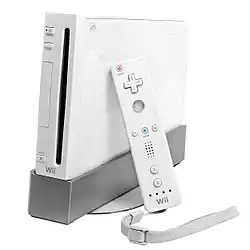
Nintendo entered the generation with a new approach embodied by its Wii. The company planned to attract current hardcore and casual gamers,[64] non-gamers,[65] and lapsed gamers by focusing on new gameplay experiences and new forms of interaction with games rather than cutting edge graphics and expensive technology.[66] This approach was previously implemented in the portable market with the Nintendo DS.[67] Nintendo expressed hope that the new control schemes it had implemented would render conventionally controlled consoles obsolete, leading to Nintendo capturing a large portion of the existing market as well.[68] This strategy paid off, with demand for the Wii outstripping supply throughout 2007.[69] Since Nintendo profited on each console right from the start unlike its competitors,[70] it achieved very positive returns.[71] With only a few exceptions, monthly worldwide sales for the Wii were higher than those of the Xbox 360 and PlayStation 3,[30][72][73] eroding Microsoft's early lead and widening the gap between its market share and Sony's.[67] In 2007, it was reported by the British newspaper Financial Times that the Wii's sales surpassed those of the Xbox 360, which had been released one year previously, and became the market leader in worldwide home console sales for the generation.[74]
As in previous generations, Nintendo provided support for its new console with first-party franchises like Mario, The Legend of Zelda, Metroid, and Pokémon. To appeal to casual and non-gamers, Nintendo developed a group of core Wii games, consisting of Wii Sports, Wii Play, Wii Fit,[75] and Wii Music,[76] where players make use of the motion-sensing abilities of the console and its peripherals to simulate real world activities.[77]
Publishers such as Ubisoft, Electronic Arts, Capcom, and Majesco Entertainment continued to release exclusive titles for the console, but the Wii's strongest titles remained within its first-party line-up. Analysts speculated that this would change in time as the Wii's growing popularity persuaded third-party publishers to focus on it;[72][78] however, some third-party developers expressed frustration at low software sales.[79] Goichi Suda, developer of No More Heroes for the Wii, noted that "only Nintendo titles are doing well" and that he "expected more games for hardcore gamers."[80] Conversely, the PAL publisher of No More Heroes Rising Star Games were greatly impressed with the game's sales.[81] Goichi Suda later retracted his comment, saying his "point was that No More Heroes, unlike a lot of Nintendo Wii titles currently available is the kind of product that will attract a different kind of consumer to the hardware."[82]
In early 2008, the NPD Group revealed sales data showing that, while the Wii's life-to-date attach rate was low, in December 2007, it reached 8.11—higher than the attach rates for the Xbox 360 and PlayStation 3 in that month.[83] The Wii's low overall attach rate could be explained by reference to its rapidly increasing installed base, as financial analysts have pointed to the Xbox 360's high attach rates as indicative of an unhealthy lack of installed base growth, and warned that what actually benefits third-party developers is "quicker adoption of hardware and a rapidly growing installed base on which to sell progressively more game units," which tends to lower the attach rate of a product.[84]
Comparison
| Console | Xbox 360 | PlayStation 3 | Wii |
|---|---|---|---|
| Logo |  |
.svg.png.webp) |
|
| Manufacturer | Microsoft | Sony Interactive | Nintendo |
| Image(s) | 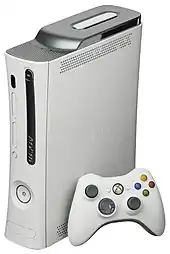  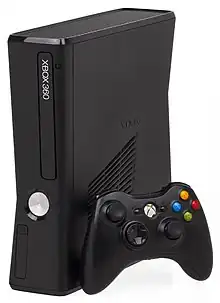 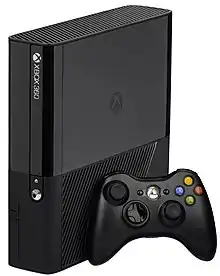 |
   |
 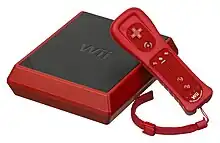 |
| Top: An original model Xbox 360 Premium and the redesigned Xbox 360 Arcade with controllers Bottom: A redesigned model Xbox 360 S and the latest Xbox 360 E with controllers |
Top: An original model PlayStation 3 and DualShock 3 controller Middle: A "slim" model PlayStation 3 and DualShock 3 controller Bottom: A "super slim" model PlayStation 3 and DualShock 3 controller |
Top: An original model Wii and Wii Remote Bottom: A Wii Mini and Wii Remote Plus | |
| Release dates | More... | More... | Wii: Wii Family Edition: Wii Mini: More... |
| Discontinued |
|
Wii/Wii Family Edition:
| |
| Units sold | >84 million [88] | >87.4 million [89] | 101.63 million [90] |
| Media | DVD-DL | Blu-ray Disc | Wii Optical Disc (proprietary DVD-DL) |
| Best-selling game |
Kinect Adventures (pack-in with Kinect peripheral), 24 million[91] |
Grand Theft Auto V, 17.27 million[93] |
Wii Sports (pack-in, except in Japan), 82.87 million (As of March 31, 2019)[94] |
| CPU | 3.2 GHz IBM PowerPC tri-core codenamed "Xenon" | Cell Broadband Engine (3.2 GHz Power ISA 2.03-based PPE with seven 3.2 GHz SPEs) | 729 MHz PowerPC-based IBM "Broadway"[95] |
| GPU | 500 MHz codenamed "Xenos" (ATI custom design) | 550 MHz RSX 'Reality Synthesizer'[96] (based on NVIDIA G70 architecture)[97] | 243 MHz ATI "Hollywood" |
| Memory | 512 MB GDDR3 @ 700 MHz shared between CPU & GPU 10 MB EDRAM GPU frame buffer memory |
256 MB XDR @ 3.2 GHz 256 MB GDDR3 @ 650 MHz |
24 MB "internal" 1T-SRAM integrated into graphics package 64 MB "external" GDDR3 SDRAM 3 MB GPU frame buffer memory |
| Dimensions |
Original: 310 × 80 × 260 mm (12.2 × 3.2 × 10.2 in)[98] |
Original: 325 × 98 × 274 mm (12.8 × 3.9 × 10.8 in)[100] |
Wii / Wii Family Edition: 4.4 × 16 × 21.5 cm (1,513.6 cm3) / 1.7 × 6.3 × 8.5 in (92.4 in3) |
| Weight |
Original: 3.5 kg (7.7 lb)[98] |
Original: 5 kg (11 lb)[100][102] |
Wii / Wii Family Edition: 1.2 kg (2.6 lb)[105] |
| Included accessories[a] |
^note 1 250 GB "Super Elite" consoles come with 2 Wireless controllers. 320 GB Xbox 360 S consoles come with a "transforming d-pad" controller. |
|
|
| Accessories (retail) |
| ||
| Controller[b] |
|
|
|
| User interface | Xbox 360 Dashboard New Xbox Experience (NXE) |
XrossMediaBar (XMB) | Wii Menu |
| System software features |
|
| |
| Backward compatibility | 465 Selected Xbox games (as of November 2007). Additions made with software updates. Official Xbox hard drive required. | The first generation model is backwards compatible with PS1 and PS2 titles through the inclusion of the Emotion Engine and Graphics Synthesizer chips.[111] The second generation model offers less backward compatibility for PS2 titles. Owing to only featuring the Graphics Synthesizer, and having to emulate the CPU.[112] |
Supports all GameCube software and most accessories. The "Family Edition" and "Mini" models drops support for GameCube games.[114] |
| Online servicesd |
Xbox Live |
Remote Play |
Nintendo Wi-Fi Connection |
| Video and entertainment services |
4oD* (UK Only; Xbox Live Gold required) |
4oD (UK only, via internet browser)[115] |
BBC iPlayer (UK only) |
| Consumer programmability | Development on PC with XNA Game Studio ($99/year subscription, binary distribution with XNA 1.0 Refresh)[124] | Featured development on console (excluding RSX graphics acceleration) via free Linux platform or PC (excluding all Slim models and any console updated to firmware 3.21 and later) | Homebrew Channel (Unofficial) |
| I/O |
IrDA-compliant infrared for remote |
Bluetooth 2.1 EDR *2 USB 2.0 ports on 3rd gen and 4th gen (slim) models |
Bluetooth 2.0 |
| Optical media | 12× DVD (65.6–132 Mbit/s), CD | 2× BD-ROM (72 Mbit/s), 8× DVD, 24× CD, 2× SACD* *Compatibility removed in 3rd & 4th gen models |
Wii Optical Disc, GameCube Game Disc (DVD-Video playback was announced for Japan in 2007, but has not been released)[127] |
| Video outputs | HDMI 1.2a (on models manufactured after August 2007),[128] VGA (RGBHV),[129] Component/D-Terminal (YPBPR), SCART (RGBS), S-Video, Composite | HDMI 1.3a, Component/D-Terminal (YPBPR), SCART (RGBS), S-Video, Composite | Component/D-Terminal (YPBPR), SCART (RGBS), S-Video, Composite |
| Resolutions | HDTV-capable (480i, 480p, 576i (50 Hz), 576p, 720p, 1080i, 1080p) Various monitor resolutions available via VGA and HDMI/DVI (640×480, 848×480, 1024×768, 1280×720, 1280×768, 1280×1024, 1360×768, 1440×900, 1680×1050 & 1920×1080) |
HDTV-capable (480i, 480p, 576i, 576p, 720p, 1080i, 1080p) | EDTV-capable (240p, 480i, 480p, 576i) |
| Audio | Dolby Digital, WMA Pro, DTS*, DTS-ES* *(DVD and HD DVD movies only)
|
Dolby Digital, DTS, Dolby Digital Plus*, Dolby TrueHD*, DTS-HD Master Audio*, DTS-HD High Resolution Audio*,[130] DTS-ES‡, DTS 96/24‡, DTS-ES Matrix†[131] *DVD and Blu-ray movies only. ‡DVD movies only. †Blu-ray movies only.
|
Dolby Pro Logic II surround, stereo sound and an additional Mono speaker is built into the controller.
|
| Network | 100BASE-TX Ethernet Optional 802.11a/b/g/n Wi-Fi adapter (Built in with the Slim models) |
10BASE-T/100BASE-TX/1000BASE-T Ethernet Built-in 802.11 b/g Wi-fi (all models except 20 GB) |
Built-in 802.11 b/g Wi-fi Optional Ethernet via USB adapter |
| Storage |
Included/Optional* detachable SATA upgradeable 20 GB, 60 GB, 120 GB, 250 GB, 320 GB, or 500 GB hard drive. |
2.5-inch upgradeable SATA hard drive (upgradeable with any 2.5-inch SATA 1.0 compliant HDD or SSD). |
512 MB built-in flash memory |
| Integrated 3DTV support[c] | Yes | No | Yes |
^a Game packages not listed. Bundles, special editions and limited editions may include additional or exchanged items.
^b There is a variety of other input devices available for all three consoles, including rhythm game controllers, microphones and third-part gamepads/controllers.
^c All consoles are capable of producing 3D images using anaglyph or frame-compatible systems (side-by-side/SbS, top and bottom/TaB), as these do not require any special output hardware. As such, these display modes are dependent on the software being displayed rather than the console.
^d Facebook and Twitter apps for Xbox 360 were retired in October 2012.[132]
Sales standings
Worldwide figures are based on data from the manufacturers. The Canada and the United States figures are based on data from the NPD Group, the Japan figures are based on data from Famitsu/Enterbrain, and the United Kingdom figures are based on data from GfK Chart-Track.
| Region | Wii | PlayStation 3 | Xbox 360 | Total |
|---|---|---|---|---|
| Australia | 2 million[133] (as of October 2010) |
1.8 million[134] (as of December 31, 2010) |
1.2 million[135] (as of April 20, 2010 and include sales from New Zealand) |
4.2 million |
| Canada | 2 million[136] (as of December 16, 2009) |
2 million[137] (as of October 6, 2010) |
870,000[138] (as of July 31, 2008) |
4.4 million |
| Europe | 25 million[139] (as of December 2010) |
15.7 million[139] (as of December 2010) |
13.7 million[139] (as of December 2010) |
53.4 million |
| Japan | 12.75 million[140] (as of December 31, 2013) |
11 million[141] (as of April 11, 2010) |
1.5 million[142] (as of February 28, 2010) |
24.0 million |
| United States | 39 million[143] (as of February 28, 2011) |
16.9 million[139] (as of December 2010) |
25.6 million[139] (as of December 2010) |
79.8 million |
| Worldwide | 101.63 million[140] (as of June 30, 2017) |
87.4 million[144] (as of March 31, 2017) |
84 million[145][146] (as of June 9, 2017) |
273.03 million |
Discontinuations and revisions
- The PlayStation 3 20 GB was discontinued in North America in April 2007[147] and effectively discontinued in Japan in early 2008.[148]
- The PlayStation 3 60 GB was discontinued in NTSC territories by September 2007, and replaced with the 80 GB version.[149]
- The PlayStation 3 60 GB was effectively discontinued for PAL territories in late 2007. When the remaining stock in stores was sold, the 40 GB version served as its replacement.
- Sony announced before the PS3 launch in Europe that the PlayStation 2's Emotion Engine CPU would be removed from it for cost savings, and all backwards compatibility would be software-based.[150] This is also the same for the 80 GB model launched in the North American market in 2007.[151]
- An HDMI out port was added to the Premium Xbox 360 in May 2007.[152]
- The Xbox 360 Core system was discontinued and replaced by the "Arcade" version in October 2007.[153]
- The price of the Xbox 360 Premium version was dropped to US$299 in North America on July 13, 2008. Supplies of the existing 20 GB model were exhausted by early August and it was replaced by an identical model with a 60 GB HDD at a MSRP of US$349.[154]
- The PlayStation 3 40 GB was discontinued in all territories in early August 2008 and the new 80 GB version served as its replacement.
- The Xbox 360 Arcade 256 MB internal memory SKU was discontinued in all territories in early 2009 and a new 512 MB internal memory SKU still named the Xbox 360 Arcade was released.[155]
- The PlayStation 3 Slim was introduced on August 18, 2009. At US$299, it is US$100 cheaper than the previous model; it is also approximately 1⁄3 lighter and more energy efficient.[156] The two original PS3 Slim models, priced at US$299.99 and US$349.99 respectively, hold 120/250 GB. These were then superseded by 160 GB and 320 GB models, which are priced at US$249.99 and US$299.99 respectively.
- The black Wii console was released in Japan on August 1, 2009[157] and in Europe in November 2009.[158]
- The Wii package for North America has been updated to include a copy of Wii Sports Resort as well as the required Wii MotionPlus accessory to play it, beginning May 9, 2010. The console is also available in black.[159]
- A special edition red Wii console was released in honor of Super Mario Bros. 25th Anniversary.
- The Xbox 360 S was announced at E3 2010 by Microsoft. It is a smaller revision of the Xbox 360 hardware, which includes either a built-in 250 GB hard drive or 4 GB of Flash storage, 802.11n Wi-Fi, a TOSLINK connector, 5 USB ports and an AUX connector for the Kinect sensor device.[160]
- The Wii Family Edition was released on October 23, 2011. It drops support for GameCube games and accessories, and is designed to sit horizontally.[114]
- The PlayStation 3 Super Slim was released on September 25, 2012.[161] It has manual sliding disc cover instead of a motorized loading slot disc cover.
- The Wii Mini was released on December 7, 2012.[162] It has a top-loading disc drive instead of a motorized loading slot disc drive and drops Wi-Fi support, online connectivity and the SD card slot.
- The Xbox 360 E was revealed and released at E3 2013 on June 10, 2013.[163] It featured a new slimmer design, that was quieter than previous models.
Backward compatibility
Early models of the Wii are fully backwards compatible with GameCube software and most of its accessories; the Wii Family Edition and the Wii Mini iterations lack GameCube support.[114] Early models of the PlayStation 3 and all models of the Xbox 360 only offer partial support and use software emulation for backwards compatibility. Later models of the PS3 do not offer PlayStation 2 compatibility, though PS1 compatibility is retained. Some models of the first generation of the PS3 offered full backwards compatibility for PS2 games. The Xbox 360's compatibility is increased through game-specific patches automatically downloaded from Xbox Live or downloaded and burned to a CD or DVD from the Xbox website[164] and the PS3's compatibility is expanded with firmware updates.
All three consoles provide titles from older consoles for download; the Xbox 360 through the Xbox Originals service, the PlayStation 3 through the PlayStation Store, and the Wii through the Virtual Console. When purchased, the game is saved to console's internal memory or, optionally on the Wii, to an inserted SD/SDHC card. Initially the Xbox 360 also provided Xbox Live support for backwards compatible games, but the service has since been discontinued for original Xbox games. No more games will be added to the list of backwards compatible games for the Xbox 360. In response to the lack of backward compatibility for most PS3s, many popular games have been released for download as PlayStation 2 Classics and other popular series have been updated with gameplay/graphics as high-definition remasters for PlayStation consoles and have been released on Blu-ray Disc or are available for download on the PlayStation Network.
HDTV-capable video support and service
Both the PlayStation 3[165] and the Xbox 360[166] support 1080p high definition video output. However, the output signal may be protected by digital rights management and may require an HDCP-compliant display if HDMI is used. The Xbox Live Marketplace service and the PlayStation Store offer HD movies, TV shows, movie trailers, and clips for download to the console's HDD.[167][168] Other regional PlayStation Stores only allow download of movie trailers and short segment clips. As of November 2009, the Video Download service present on the American PlayStation Store will be available for select European countries.
While only a small number of games render video in native 1080p, many games can be automatically scaled to output this resolution. The Wii is capable of outputting 480p for the Wii Menu and most games through a component cable, which must be purchased separately.
Reliability
In the September 2009 issue of Game Informer magazine, survey results were published in which among nearly 5000 readers who responded, 54.2% of those who owned an Xbox 360 had experienced a console failure for that system, compared with 10.6% for PlayStation 3, and 6.8% for Wii.[169]
In August 2009, warranty provider SquareTrade published console failure rate estimates, in which the proportion of its customers reporting a system failure in the first two years is 23.7% for Xbox 360, 10.0% for PlayStation 3, and 2.7% for Wii.[170]
Handheld systems
For video game handhelds, the seventh generation began with the release of the Nintendo DS on November 21, 2004. This handheld was based on a design fundamentally different from the Game Boy and other handheld video game systems. The Nintendo DS offered new modes of input over previous generations such as a touch screen, the ability to connect wirelessly using IEEE 802.11b, as well as a microphone to speak to in-game NPCs.[171] On December 12, 2004, Sony released its first handheld, PlayStation Portable. The PlayStation Portable was marketed at launch to an above-25-year-old[172] or "core gamer" market,[173] while the Nintendo DS proved to be popular with both core gamers and new customers.[174]
Nokia revived its N-Gage platform in the form of a service for selected S60 devices. This new service launched on April 3, 2008.[175] Other less-popular handheld systems released during this generation include the Gizmondo (launched on March 19, 2005, and discontinued in February 2006) and the GP2X (launched on November 10, 2005, and discontinued in August 2008). The GP2X Wiz, Pandora, and Gizmondo 2 were scheduled for release in 2009.
Another aspect of the seventh generation was the beginning of direct competition between dedicated handheld gaming devices, and increasingly powerful PDA/cell phone devices such as the iPhone and iPod Touch, and the latter being aggressively marketed for gaming purposes. Simple games such as Tetris and Solitaire had existed for PDA devices since their introduction, but by 2009 PDAs and phones had grown sufficiently powerful to where complex graphical games could be implemented, with the advantage of distribution over wireless broadband.
Sony announced in 2014 that they had discontinued the production of the PlayStation Portable worldwide.
Handheld game console comparison
| Product Line | Nintendo DS family | PlayStation Portable | ||
|---|---|---|---|---|
| Console | Nintendo DS / Nintendo DS Lite / Nintendo DSi / Nintendo DSi XL | PSP-1000 / PSP-2000 / PSP-3000 / PSP Go / PSP-E1000 | ||
| Manufacturer | Nintendo | Sony (SCE) | ||
| Console | 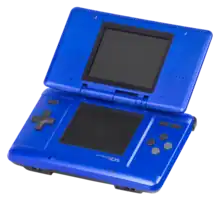   
|
   
| ||
| Release dates |
|
PSP: PSP Go: | ||
| Discontinuation | Yes; date undisclosed[176] | 2014[177] | ||
| Media | Nintendo DS Game Card, Game Boy Advance cartridge (DS, DS Lite only), SD (HC) Card (DSi only) | Universal Media Disc (UMD) (PSP-1000, PSP-2000, PSP-3000 and PSP-E1000 series only), Memory Stick Duo (PSP-1000, PSP-2000, PSP-3000 series only), Memory Stick Micro (M2), Flash memory (PSP Go only), Content delivery via PSN (All) | ||
| Best-selling game | New Super Mario Bros., 30.80 million (as of March 31, 2019)[178] | Grand Theft Auto: Liberty City Stories 2 million (as of Fall 2008)[179] | ||
| Included accessories and extras |
|
| ||
| Accessories (retail) |
| |||
| CPU | DS and DSL: 67 MHz ARM9 and 33 MHz ARM7 DSi: 133 MHz ARM9 and 33 MHz ARM7 |
MIPS R4000-based; clocked from 1 to 333 MHz (2 of these) | ||
| Memory | DS and DSL: 4 MB SRAM DSi: 16 MB |
EDRAM (5 MB reserved for kernel, 3 for music) PSP-1000: 32 MB PSP-2000, PSP-3000, PSP Go: 64 MB | ||
| Interface |
|
| ||
| Dimensions | DS: 148.7 × 84.7 × 28.9 mm (5.85 × 3.33 × 1.13 inches) DS Lite: 133 × 73.9 × 21.5 mm (5.24 × 2.9 × 0.85 inches) |
PSP 1000: 74 mm (2.9 in) (h) 170 mm (6.7 in) (w) 23 mm (0.91 in) (d) PSP Slim & Lite:71.4 mm (2.81 in) (h) 169.4 mm (6.67 in) (w) 18.6 mm (0.73 in) (d) PSP Go: 69 mm (2.7 in) (h) 128 mm (5.0 in) (w) 16.5 mm (0.65 in) (d) | ||
| Weight | DS: 275 g (9.7 oz) DSL: 218 g (7.7 oz) DSi: 214 g (7.5 oz) DSi XL: 314 g (11.1 oz) |
PSP 1000: 280 g (9.9 oz) PSP Slim & Lite 189 g (6.7 oz) PSP Go: 158 g (5.6 oz) | ||
| Online service | Nintendo Wi-Fi Connection, DSi Shop (DSi only), DSi camera(DSi only), DSi sound(DSi only), Internet browser(DSi only), Flipnote Hatena(DSi only), Facebook(DSi XL only) | PlayStation Network, RSS reader, Skype (PSP-2000 series, PSP-3000 series and PSP Go only), PlayStation Store
Internet browser, Digital comics, Remote Play | ||
| Backward compatibility | Game Boy Advance (DS, DS Lite only) | PlayStation (downloadable PSone Classics only), TurboGrafx-16/TurboGrafx-CD (via PlayStation Store), Neo Geo (via PlayStation Store) | ||
| System software | Nintendo DS Menu (DS, DS Lite), Nintendo DSi Menu (DSi) | XrossMediaBar (XMB) | ||
| Consumer programmability | See Nintendo DS homebrew | See PlayStation Portable homebrew | ||
| Resolutions | 256 × 192 (both screens) | 480 × 272 | ||
| Colors | 18-bit color (about 260k colors) | 24-bit color (about 17m colors) | ||
| Network | Wi-Fi 802.11b, Wi-Fi 802.11g (DSi only, only functions with DSi-specific software), wireless ad hoc with other DS units and Nintendo Wii | Wi-Fi 802.11b (PSP-1000, PSP-2000, PSP-3000 and PSP Go only), IrDA (PSP-1000 series only), Bluetooth (PSP Go only), wireless ad hoc with other PSP units and PS3 | ||
| Audio | Stereo speakers, headphone jack, with 16 PCM/ADPCM channels | Stereo speakers, headphone jack | ||
| I/O | 1 Nintendo DS Game Card slot 1 GBA slot (DS, DS Lite only) 1 SD (HC) card slot (DSi Only) |
UMD drive (PSP-1000, PSP-2000, PSP-3000 and PSP-E1000 series only) 1 USB device port (proprietary connector on PSP Go, mini-b connector on other models) 1 Memory Stick Duo/PRO Duo slot (Memory Stick Micro (M2) on PSP Go) 1 IrDA (PSP-1000 series only) | ||
| Storage | Nintendo DS Game Card, SD (HC) card (DSi only) | Memory Stick Duo/PRO Duo (Memory Stick Micro (M2) on PSP Go), 16 GB flash memory (PSP Go only) | ||
| Battery life | DS, backlight on: 14 hours DS Lite, minimum brightness setting: 15–19 hours[180] DSi, minimum brightness setting: 9–14 hours[180] |
MP3 playback: 10 hours Game: approximately 3–6 hours Video playback: 3–7 hours depending on screen brightness setting Wi-Fi internet browsing: approximately 3–4 hours | ||
| Units sold (all models combined) | Worldwide: 154.02 million (as of September 31, 2016)[140] Japan: 32.99 million (as of December 31, 2013)[140] |
Worldwide: 82 million (as of June 2016)[184]
Japan: 11,078,484 (as of December 28, 2008)[185][186] |
Note: First year of release is the first year of the system's worldwide availability.
Other systems
There were also other consoles released during the seventh generation time period. Generally, they are either niche products or less powerful.
Home video game consoles
| Console | Manufacturer | Release date | Notes |
|---|---|---|---|
| EVO Smart Console | Envizions | 2006 | Can be considered as a Media PC |
| Zeebo | Zeebo Inc. | 2009 | Designed for emerging countries. Sold in Mexico, Brazil and China only |
| HyperScan | Mattel | 2006 | Designed for children's use |
| Game Wave Family Entertainment System | ZAPiT Games | 2005 | Family-friendly built-in games |
| Vii | JungleTac | 2007 | Chinese Wii clone |
| V.Flash | VTech | 2006 | |
| V.Smile V-Motion | VTech | 2008 | |
| V.Smile Baby | VTech | 2006 | |
| ClickStart | LeapFrog | 2007 | |
| Swinxs | Swinxs BV | 2008 | Screenless semi-portable game console for children. |

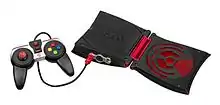
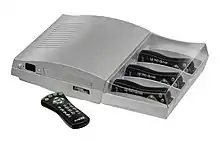 Game Wave Family Entertainment System, commonly abbreviated as Game Wave
Game Wave Family Entertainment System, commonly abbreviated as Game Wave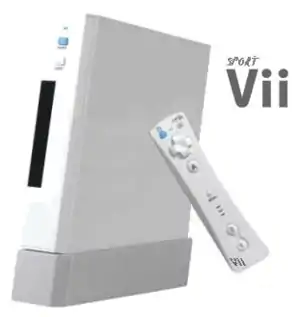
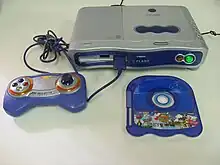
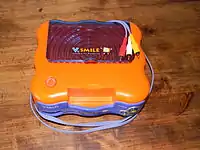

Handhelds
| Name | Manufacturer | Release date | Notes |
|---|---|---|---|
| N-Gage 2.0 Platform | Nokia | April, 2008 | Runs commercial downloadable games |
| Gizmondo | Tiger Telematics | March, 2005 in UK, Sweden and eventually US | Runs commercial games |
| VideoNow XP | Tiger Electronics | 2005 | |
| digiBlast | Grey Innovation | late 2005 | Multimedia system for young children |
| CAANOO | GamePark Holdings | August 16, 2010 | Runs emulators |
| Fusion: 30-In-1 Portable Arcade | Jungle Soft | 2010? | Built-in games |
| GP2X Wiz | GamePark Holdings | May 12, 2009 | |
| Leapster2 | LeapFrog Enterprises, Inc. | 2008 | Educational games |
| Leapster Explorer | LeapFrog Enterprises, Inc. | 2010 | Educational games and downloadable apps |
| Mi2 / PDC Touch | Planet Interactive / Conny Technology / Videojet | November 2009 – Benelux, China, France, Spain, Germany, United Kingdom, Portugal |
Many built-in games |
| Pandora | OpenPandora | May 2010 | Runs on Linux and designed for homebrew |
| Pelican VG Pocket | Pelican Accessories | August 2006 |
Released in China only
| Name | Manufacturer | Release date |
|---|---|---|
| Dingoo A320 | Shenzhen Dingoo Digital Co., Ltd. | March 2009 |
| Ez MINI | Mitac or Mio | 2005 |
| Gemei X760+ | Gemei | 2009 |
| LetCool N350JP | 2011 |
Released in South Korea only
| Name | Manufacturer | Release date |
|---|---|---|
| GP2X | GamePark Holdings | November 10, 2005 |
Clones
Cloud gaming/gaming on demand services
| Name | Manufacturer | Release date |
|---|---|---|
| OnLive | OnLive | June 17, 2010 |
| Gaikai | Gaikai | February 27, 2011 |
| OTOY | OTOY | |
| Playcast Media Systems | ||
| G-cluster | ||
| Spoon.net |
 OnLive Micro Console
OnLive Micro Console
See also
Notes
References
- Wisniowski, Howard (May 9, 2006). "Analog Devices And Nintendo Collaboration Drives Video Game Innovation With iMEMS Motion Signal Processing Technology". Analog Devices, Inc. Archived from the original on January 7, 2015. Retrieved May 10, 2006.
- Martin Hilbert and Priscila López (2011). "The World's Technological Capacity to Store, Communicate, and Compute Information". Science. 332 (6025): 60–65. Bibcode:2011Sci...332...60H. doi:10.1126/science.1200970. PMID 21310967. S2CID 206531385. Free access to the article through martinhilbert.net/WorldInfoCapacity.html
- Stevens, Tim (March 9, 2011). "Microsoft sells 10 million Kinects, 10 million Kinect games". Engadget. Archived from the original on March 12, 2011. Retrieved March 10, 2011.
- "Kinect Confirmed As Fastest-Selling Consumer Electronics Device". Guinnessworldrecords.com. Archived from the original on March 11, 2011. Retrieved March 10, 2011.
- Bayer, Glen (March 1, 2004). "Various Satoru Iwata comments regarding the Nintendo DS". N-sider.com. Archived from the original on October 9, 2008. Retrieved October 4, 2007.
- Darkain (January 21, 2005). "Nintendo DS – WI-FI vs NI-FI". Archived from the original on February 17, 2005. Retrieved April 2, 2006.
- "E3 2003: PSP Press Release". gamedaily.com. December 31, 2003. Archived from the original on March 3, 2009. Retrieved March 12, 2008.
- "Support – PSP – Movies". "Sony Computer Entertainment. Archived from the original on March 7, 2008. Retrieved March 12, 2008.
- "PSP – About – Multimedia". Sony Computer Entertainment. Archived from the original on March 3, 2011. Retrieved March 12, 2008.
- "User's Guide – Remote Play". Sony Computer Entertainment. Archived from the original on March 11, 2008. Retrieved March 12, 2008.
- "Support – PSP – Connecting to the Internet". Sony Computer Entertainment. Archived from the original on March 15, 2008. Retrieved March 12, 2008.
- "8 reasons why the PSP might overtake the DS". Gizmodo. November 29, 2007. Archived from the original on March 23, 2008. Retrieved March 12, 2008.
- Langshaw, Mark; Reynolds, Matthew (January 13, 2013). "Can Android consoles Ouya, Project Shield challenge PlayStation, Xbox?". DigitalSpy.com. Archived from the original on February 15, 2013. Retrieved March 7, 2013.
- Kelly, Tadhg (January 10, 2013). "With Ouya, GameStick, Steam Box and more, will 2013 be the year of the 'microconsole'?". Edge Online. Archived from the original on March 17, 2013. Retrieved March 7, 2013.
- Pereira, Chris (January 15, 2013). "Digital and Nontraditional: Breaking Down Ouya, Steam Box, And Other New Wave Systems". 1up.com. Archived from the original on February 21, 2013. Retrieved March 7, 2013.
- Kohler, Chris (June 11, 2018). "Ubisoft Just Announced A Wii Game". Kotaku. Archived from the original on January 18, 2021. Retrieved February 19, 2019.
- "JUST DANCE 2020 ANNOUNCED DURING UBISOFT E3 CONFERENCE - E3 2019". IGN. June 10, 2019. Archived from the original on November 12, 2020. Retrieved June 11, 2019.
- "Muted hello for Xbox 360 in Japan". BBC. December 10, 2005. Archived from the original on November 9, 2020. Retrieved October 28, 2007.
- Fildes, Johnathan (September 23, 2006). "Xbox still hopes to storm Japan". BBC. Archived from the original on January 26, 2021. Retrieved October 30, 2007.
- Haigh, Marilyn (October 8, 2019). "Why Japanese gamers don't buy Xbox". CNBC. Archived from the original on October 31, 2019. Retrieved July 4, 2022.
- "Features -- Why Xbox Failed in Japan". www.japan-zone.com. Archived from the original on June 28, 2022. Retrieved July 4, 2022.
- "Xbox 360 Warranty Coverage Expanded". Microsoft. July 5, 2007. Archived from the original on October 14, 2008. Retrieved October 25, 2007.
- Block, Gerry (June 12, 2008). "Xbox 360 RRoD Failures Finally Explained". IGN. Archived from the original on May 24, 2022. Retrieved May 24, 2022.
- Perry, Douglass (May 20, 2005). "E3 2005: Microsoft's Xbox 360 vs. Sony's PlayStation 3". IGN. Archived from the original on May 12, 2008. Retrieved May 14, 2008.
- Martindale, Jon. "Guess how much Microsoft and Sony lost on the Xbox 360 and PS3?". KitGuru. Archived from the original on September 6, 2022. Retrieved May 24, 2022.
- Doerr, Nick (August 17, 2007). "Ubisoft's GRAW team denies PS3 programming difficulty". PS3 Fanboy. Archived from the original on September 26, 2018. Retrieved May 14, 2008.
- Gualco, Scott (February 7, 2006). "UPDATE PlayStation 3 Programming Predicament?". Gamer 2.0. Archived from the original on December 3, 2008. Retrieved May 14, 2008.
- McDougall, Paul (July 20, 2007). "Microsoft Xbox 360 Sales Plunge 60% As Problems Mount". InformationWeek. Archived from the original on May 9, 2008. Retrieved November 22, 2007.
- Lai, Marcus (August 30, 2007). "Wii, Xbox 360 sales up; PS3 down at Ebay". Punch Jump. Archived from the original on October 7, 2007. Retrieved November 22, 2007.
- Boyer, Brandon (October 19, 2007). "Halo 3 Drives Xbox 360 Sales Above Wii in September". Gamasutra. Archived from the original on October 21, 2007. Retrieved October 25, 2007.
- Kuchera, Ben (October 26, 2007). "Strong Halo 3 launch helps Microsoft gaming to first profit in years". Ars Technica. Archived from the original on June 7, 2011. Retrieved October 29, 2007.
- "2007 Nominee Fast Facts". Game Critics Awards. Archived from the original on May 26, 2008. Retrieved June 25, 2008.
- "2007 Winners Fast Facts". Game Critics Awards. Archived from the original on June 2, 2008. Retrieved June 25, 2008.
- Rain Anderson (February 20, 2008). "Microsoft keynote reveals Xbox stats". That VideoGame Blog. Archived from the original on June 18, 2008. Retrieved June 25, 2008.
- "Official Press Release on DMC4 going Multiplatform". Capcom. March 20, 2007. Archived from the original on October 28, 2007. Retrieved October 25, 2007.
- "Namco Bandai Games announces the worldwide launch of Ace Combat 6: fires of liberation for the Xbox 360". Namco Bandai. Archived from the original on October 11, 2007. Retrieved June 25, 2008.
- McWhertor, Michael (December 21, 2006). "PS3 Loses Another Exclusive, Virtua Fighter 5 Comes to 360". Kotaku. Archived from the original on October 25, 2007. Retrieved October 25, 2007.
- "Grand Theft Auto IV Comes to Xbox 360 on Day One". GameSpot. Archived from the original on January 23, 2013. Retrieved May 24, 2008.
- "Final Fantasy XIII Comes to the 360". X-Play. Archived from the original on May 9, 2008. Retrieved July 14, 2008.
- Ramsay, Randolph (October 8, 2008). "TGS 2008: Tekken 6 smacking Xbox 360 – News at GameSpot". Gamespot.com. Archived from the original on January 23, 2013. Retrieved March 5, 2011.
- Totilo, Stephen (June 3, 2009). "Sony Expects Metal Gear Solid Rising on PS3 at Launch". Kotaku.com. Archived from the original on May 27, 2010. Retrieved June 14, 2011.
- "L.A. Noire No Longer A PS3 Exclusive – News (PS3/Xbox 360)". News.spong.com. February 8, 2010. Archived from the original on April 18, 2010. Retrieved March 5, 2011.
- "Microsoft Store Official Site - Free Shipping, Free Returns". Microsoft Store. Archived from the original on December 11, 2015. Retrieved December 10, 2015.
- Bakalar, Jeff (August 1, 2013). "Xbox 360 E console review". CNET. CBS Interactive. Archived from the original on February 7, 2015. Retrieved February 8, 2015.
- Graft, Kris (December 8, 2006). "PS3 Manufacturing Troubles 'Solved'". Next Generation. Archived from the original on September 10, 2012. Retrieved October 25, 2007.
- "Sony's other units depend on the PS3's success". CNN. May 7, 2006. Archived from the original on June 12, 2008. Retrieved December 18, 2007.
- "PS3 fuels Blu-ray revolution says Sony Pictures". PSPSPS. September 6, 2007. Archived from the original on November 30, 2007. Retrieved December 18, 2007.
- Gibson, Ellie (March 13, 2007). "Blu-ray will help ensure success of PlayStation 3, says Harrison". GamesIndustry.biz. Archived from the original on October 7, 2008. Retrieved December 18, 2007.
- "Capcom unleashes the beast as "Monster Hunter 3 (tri-)" rumbles its way onto the Nintendo Wii". Capcom. Archived from the original on June 19, 2008. Retrieved June 25, 2008.
- Hatfield, Daemon (August 30, 2006). "Assassin's Creed Loses PS3 Exclusivity". IGN. Archived from the original on January 3, 2009. Retrieved October 25, 2007.
- Boyes, Emma (November 22, 2006). "More PS3 exclusives head to 360". GameSpot. Archived from the original on April 30, 2010. Retrieved December 18, 2007.
- Kalning, Kristin (December 2, 2007). "Sony aims for comeback win with PS3". NBC News. Archived from the original on June 14, 2013. Retrieved December 18, 2007.
- Ivan, Tom (December 16, 2007). "Hirai: Sony's Focus Is Now On PS3 Software". Next Generation. Archived from the original on September 3, 2012. Retrieved December 18, 2007.
- Brightman, James (December 7, 2007). "Interview: Jack Tretton Reflects on Year One as SCEA Chief". GameDaily. Archived from the original on January 10, 2008. Retrieved December 18, 2007.
- "PlayStation 3 Price Reveal was a 'Horrifying Moment,' Says SIE President". July 10, 2018. Archived from the original on January 16, 2021. Retrieved January 22, 2019.
- Hillis, Scott (July 9, 2007). "Sony cuts price on PlayStation 3 by $100". Reuters. Archived from the original on December 15, 2007. Retrieved October 25, 2007.
- Thorsen, Tor (July 13, 2007). "60GB PS3 'no longer in production'". GameSpot AU. Archived from the original on July 8, 2012. Retrieved October 25, 2007.
- "Sony Press Release". Sony. November 23, 2007. Archived from the original on November 23, 2007. Retrieved December 2, 2007.
- Williams, Martyn (November 23, 2007). "PS3 sales jump in US on heels of price cut". Washington Post. Archived from the original on November 10, 2012. Retrieved November 25, 2007.
- "GC 08". PS3fanboy. August 20, 2008. Archived from the original on February 4, 2009. Retrieved August 20, 2008.
- Carnoy, David. "Sony officially announces $299 PS3 Slim | Crave – CNET". News.cnet.com. Archived from the original on June 17, 2011. Retrieved March 5, 2011.
- Ashcraft, Brian (May 30, 2017). "Sony Finally Killed Off The PS3 In Japan". Kotaku. Archived from the original on August 13, 2017. Retrieved August 16, 2017.
- Ackerman, Dan (May 30, 2017). "Sony PlayStation 3 ends shipments, fulfilling 10-year promise". CNET. Archived from the original on August 16, 2017. Retrieved August 16, 2017.
- Morris, Chris (May 9, 2006). "Nintendo continues to play coy". CNN. Archived from the original on May 16, 2008. Retrieved December 12, 2007.
- Hermida, Alfred (May 10, 2006). "Nintendo shows new games console". BBC News. Archived from the original on August 10, 2017. Retrieved December 12, 2007.
- Hartley, Matt (December 10, 2007). "Reginald Fils-Aime: Nintendo goes for wild ride". The Globe and Mail. Archived from the original on December 15, 2007. Retrieved December 12, 2007.
- Gaudiosi, John (April 25, 2007). "The untold story of how the Wii beat the Xbox 360, PlayStation 3". CNNMoney. Archived from the original on December 14, 2007. Retrieved May 1, 2007.
- "Nintendo President, Satoru Iwata, media briefing speech at E3 2006". Nintendo. Archived from the original on March 28, 2007. Retrieved April 3, 2007.
- Yen, Yi-Wyn (October 5, 2007). "Wii woes for the wee ones on Xmas". CNN. Archived from the original on December 14, 2007. Retrieved October 25, 2007.
- Ehrenberg, Ron (May 3, 2007). "Game Console Wars II: Nintendo Shaves Off Profits, Leaving Competition Scruffy". Seeking Alpha. Archived from the original on October 11, 2007. Retrieved October 25, 2007.
- "Nintendo jumps ahead of Sony in market value". The Age. Melbourne. June 25, 2007. Archived from the original on November 13, 2007. Retrieved October 25, 2007.
- Levine, Barry (November 28, 2007). "Gamers Buy 350,000 Wii Consoles in Single Week". CIO Today. Archived from the original on September 30, 2013. Retrieved December 12, 2007.
- Takenaka, Kiyoshi (November 30, 2007). "Sony PS3 tops Nintendo Wii in Japan for first time". Forbes. Archived from the original on December 15, 2007. Retrieved December 12, 2007.
- Sanchanta, Mariko (September 12, 2007). "Nintendo's Wii takes console lead". Financial Times. Archived from the original on March 24, 2009. Retrieved September 12, 2007.
- Iwata, Satoru. "Part 1 – A Truly Ground-breaking Collection of Games". Iwata Asks, Volume 4: Wii Sports. Nintendo. Archived from the original on July 8, 2008. Retrieved November 9, 2009.
- Totilo, Stephen (July 15, 2008). "Nintendo Announces Wii Music, Improved Wii Remote at E3". MTV Multiplayer. MTV Networks. Archived from the original on November 3, 2012. Retrieved November 9, 2009.
- Iwata, Satoru. "Part 4 – Games That Even the People Watching Can Enjoy". Iwata Asks, Volume 4: Wii Sports. Nintendo. Archived from the original on January 10, 2008. Retrieved November 9, 2009.
- Wingfield, Nick; Iwatani Kane, Yukari (April 19, 2007). "Wii and DS Turn Also-Ran Nintendo into Winner in Videogames Business". Wall Street Journal. Archived from the original on September 19, 2020. Retrieved December 12, 2007.
- Martin, Matt (January 24, 2007). "Publishers wary of creating Nintendo titles, says Wii developer". GamesIndustry.biz. Archived from the original on December 11, 2007. Retrieved January 27, 2007.
- Hicks, Chris (January 16, 2008). "Suda 51: Third party Wii games aren't selling". CVG. Archived from the original on January 29, 2008. Retrieved January 25, 2008.
- "Rising Star enjoys Wii chart success". MCV. www.mcvuk.com. March 18, 2008. Archived from the original on August 27, 2009. Retrieved March 5, 2011.
- "Suda 51: Retracted Comment". Grasshopper Manufacture. January 20, 2008. Archived from the original on January 20, 2008. Retrieved January 21, 2008.
- Casamassina, Matt (January 24, 2008). "Wii Tie Ratio at 8:1 in December". IGN. Archived from the original on January 27, 2008. Retrieved January 25, 2008.
- Dobson, Jason (November 21, 2006). "Opinion: Xbox 360 Software Attach Rate Is 'Alarming'". Gamasutra. Archived from the original on February 4, 2008. Retrieved January 25, 2008.
- "Achievement Unlocked: 10 Years – Thank You, Xbox 360". Xbox wire. April 20, 2016. Archived from the original on February 16, 2017. Retrieved April 20, 2016.
- "PS3 Discontinued in New Zealand By Sony". PlayStation LifeStyle. October 2, 2015. Archived from the original on December 10, 2015. Retrieved December 10, 2015.
- Statt, Nick. "Nintendo says sayonara to the original Wii". CNET. Archived from the original on August 3, 2017. Retrieved June 13, 2017.
- "E3 2014: $399 Xbox One Out Now, Xbox 360 Sales Rise to 84 million". Archived from the original on October 13, 2014.
- "SIE Business Development | Sony Interactive Entertainment Inc". Archived from the original on April 27, 2019. Retrieved April 26, 2019.
- "Archived copy". Archived from the original on October 26, 2017. Retrieved October 25, 2019.
{{cite web}}: CS1 maint: archived copy as title (link) - Epstein, Zach (February 12, 2013). "MICROSOFT SAYS XBOX 360 SALES HAVE SURPASSED 76 MILLION UNITS, KINECT SALES TOP 24 MILLION". BGR.com. Archived from the original on February 15, 2013. Retrieved February 15, 2013.
- "Xbox 360 Best Selling Games Statistics". Archived from the original on January 16, 2013. Retrieved February 6, 2013.
- "PS3 Best Selling Games Statistics". Archived from the original on December 11, 2013. Retrieved December 15, 2013.
- "IR Information : Financial Data - Top Selling Title Sales Units - Wii Software". Nintendo Co., Ltd. Archived from the original on June 15, 2019. Retrieved July 12, 2019.
- Casamassina, Matt (September 19, 2006). "Nintendo Wii FAQ". IGN. Archived from the original on October 6, 2006. Retrieved April 3, 2007.
- "Sony Introduces PlayStation 3, to launch in 2006". Archived from the original on November 28, 2009. Retrieved October 5, 2008.
- "PlayStation 3's GPU – The NVIDIA RSX Reality Synthesizer". AnandTech. May 16, 2005. Archived from the original on November 28, 2009. Retrieved October 5, 2008.
- "Xbox 360 Technical Specifications". Xbox (Microsoft). Archived from the original on October 14, 2008. Retrieved October 29, 2007.
- "Xbox 360S specs". Archived from the original on October 27, 2012. Retrieved October 27, 2012.
- "PLAYSTATION3 LAUNCHES ON NOVEMBER 11, 2006 IN JAPAN" (PDF). Sony Computer Entertainment Inc. May 8, 2006. Archived from the original (PDF) on March 25, 2007. Retrieved April 3, 2007.
- "Entertainment on PS3 has a new look". NZ PlayStation.com. August 18, 2009. Archived from the original on October 22, 2009. Retrieved September 23, 2009.
- "About PlayStation3 – Technical Specifications". PlayStation (Sony). Archived from the original on January 18, 2008. Retrieved October 29, 2007.
- "Greener, lighter, 320GB PS3 confirmed". Eurogamer. June 20, 2011. Archived from the original on June 23, 2011. Retrieved June 21, 2011.
- "Sony reveals new "Super Slim" PS3 hardware redesign". Ars Technica. December 21, 2012. Archived from the original on November 24, 2012. Retrieved December 21, 2012.
- Allen, Danny (November 17, 2006). "A Closer Look at the Nintendo Wii". PC World. Archived from the original on February 5, 2008. Retrieved April 3, 2007.
- "Nintendo Wii mini with Mario Kart Wii Game (Red) RVOSRAAC". B&H. Archived from the original on March 1, 2022. Retrieved February 28, 2022.
- "Xbox 360 DivX/XviD Playback Tested (Verdict: It's Almost Perfect)". December 4, 2007. Archived from the original on May 29, 2008. Retrieved June 24, 2008.
- "Xbox 360 Media Download Center". Xbox (Microsoft). Archived from the original on October 29, 2007. Retrieved October 30, 2007.
- "SD Cards". Nintendo. Archived from the original on February 12, 2008. Retrieved April 3, 2007.
- Burman, Rob (August 8, 2007). "Keyboard Functionality Added to Wii". IGN UK. Archived from the original on January 23, 2009. Retrieved August 8, 2007.
- Gantayat, Anoop (November 12, 2006). "PS3 Backwards Compatibility Issues – New system has some problems with past titles". IGN. Archived from the original on February 5, 2012. Retrieved April 3, 2007.
- "Playstation 3 80GB's PS2 backwards compatibility sucks". Archived from the original on October 11, 2007. Retrieved December 5, 2011.
- "Official PlayStation website – PS3 FAQ". Archived from the original on January 4, 2009. Retrieved December 2, 2007.
- Davison, Pete (October 12, 2011). "New 'Family Edition' Wii Drops Gamecube Support". GamePro. Retrieved December 5, 2011.
- Pickard, Rose (December 14, 2010). "ITV Player And 4oD Are Now Available on PS3". PlayStation.blog; Sony. Archived from the original on December 18, 2010. Retrieved December 17, 2010.
- "iPlayer on Its Way? | Gaming News and Opinion at". Thesixthaxis.com. October 25, 2008. Archived from the original on September 20, 2011. Retrieved June 28, 2011.
- "LOVEFiLM Heading To PS3 | Gaming News and Opinion at". Thesixthaxis.com. October 10, 2010. Archived from the original on January 7, 2011. Retrieved June 28, 2011.
- "Watch Major League Baseball on PS3! MLB.TV App Live Today – PlayStation Blog". Blog.us.playstation.com. April 22, 2010. Archived from the original on May 11, 2012. Retrieved June 28, 2011.
- "PS3 + MUBI + YOU – PlayStation.Blog.Europe". Blog.eu.playstation.com. May 18, 2010. Archived from the original on September 28, 2011. Retrieved June 28, 2011.
- "Music". Qriocity. Archived from the original on July 17, 2011. Retrieved June 28, 2011.
- "Netflix launches in Canada today: streaming only service for C$7.99 per month". Engadget. September 22, 2010. Archived from the original on June 29, 2011. Retrieved June 28, 2011.
- "Ondemand available on PlayStation3". Tvnz.co.nz. April 20, 2010. Archived from the original on June 13, 2011. Retrieved June 28, 2011.
- "Crunchyroll App Now Available on Nintendo Wii". Archived from the original on October 16, 2015. Retrieved June 25, 2016.
- "XNA Game Studio Express". MSDN (Microsoft). Archived from the original on September 25, 2008. Retrieved October 30, 2007.
- "Wiiの概要 (Wii本体)" (in Japanese). Nintendo. Archived from the original on June 15, 2006. Retrieved April 3, 2007.
- "Wii to Support SDHC, Not a Hard Drive". Gizmodo. March 25, 2009. Archived from the original on April 9, 2009. Retrieved April 14, 2009.
- Farivar, Cyrus (November 17, 2006). "Nintendo confirms Wii DVD playback only for Japan, for now". Engadget. Archived from the original on May 2, 2016. Retrieved April 3, 2007.
- Block, Ryan (August 8, 2007). "Microsoft officially adds HDMI to Xbox 360 Premium". Engadget. Archived from the original on October 15, 2007. Retrieved October 30, 2007.
- "Product information – Xbox 360 VGA HD AV Cable". xbox.com. Microsoft. Archived from the original on March 24, 2007. Retrieved April 3, 2007.
- "System Software Update History". SONY Computer Entertainment America. Archived from the original on February 5, 2008. Retrieved April 15, 2008.
- "Update features (ver 2.40)". SCEE. Archived from the original on December 29, 2008. Retrieved July 2, 2008.
- "Xbox Live 'retires' Twitter/Facebook apps as of today". Destructoid. October 19, 2012. Archived from the original on October 21, 2012. Retrieved October 21, 2012.
- "Wii Sells Through More Than Two Million Units". Nintendo Australia. November 8, 2010. Archived from the original on November 13, 2010. Retrieved November 18, 2010.
- Hill, Jason (February 9, 2011). "Game retail sales drop". The Sydney Morning Herald. Archived from the original on February 11, 2011. Retrieved February 9, 2011.
- Leigh Alexander (March 20, 2010). "Xbox Hits 1 Million Across Australia, New Zealand". Gamasutra. United Business Media. Archived from the original on April 23, 2010. Retrieved April 23, 2010.
- "Nintendo News: More Than Two Million Wii Consoles Sold In Canada". Nintendo Canada. December 15, 2009. Archived from the original on December 19, 2010. Retrieved March 31, 2011.
- Peter Nowak (October 6, 2010). "Sony aims for PS3 holiday sales boost". CBC. Archived from the original on October 9, 2010. Retrieved October 31, 2010.
- Neil Davidson (August 26, 2008). "Nintendo Wii surpasses mark of one million consoles sold in Canada". The Canadian Press. Yahoo!. Archived from the original on September 8, 2008. Retrieved September 8, 2008.
- Alexander, Leigh (March 31, 2011). "GameStop Details Europe, U.S. Installed Base For Consoles". Gamasutra. United Business Media. Archived from the original on April 4, 2011. Retrieved March 31, 2011.
- "Consolidated Sales Transition by Region" (PDF). Nintendo. May 8, 2014. Archived from the original (PDF) on May 8, 2014. Retrieved May 8, 2014.
- Ben Reeves (April 13, 2010). "Yakuza 4 One of Japan's Best Selling PS3 Games". Game Informer. Archived from the original on August 25, 2019. Retrieved April 24, 2010.
- Alexander, Leigh (March 1, 2010). "Wii Japan Total Passes 10 Million". Gamasutra. United Business Media. Archived from the original on March 6, 2010. Retrieved March 22, 2010.
- Orry, James (March 11, 2011). "Wii has sold 35 million units in the US". VideoGamer.com. Archived from the original on July 11, 2012. Retrieved March 28, 2011.
- "SIE Business Development". Sony Computer Entertainment. April 26, 2018. Archived from the original on April 27, 2019. Retrieved April 26, 2018.
- "Xbox Delivers Winning Lineup of Exclusive Games for this Holiday Season". June 9, 2014. Archived from the original on September 12, 2020. Retrieved September 20, 2020.
- Eddie Makuch (June 9, 2014). "E3 2014: $399 Xbox One Out Now, Xbox 360 Sales Rise to 84 million". GameSpot. Archived from the original on July 11, 2014. Retrieved September 19, 2014.
- Thorsen, Tor; Emma Boyes (April 11, 2007). "20 GB PS3 officially discontinued in North America". GameSpot. Archived from the original on April 15, 2007. Retrieved April 15, 2007.
- Boyes, Emma (January 10, 2008). "Sony discontinuing 20GB and 60GB PS3 in Japan". GameSpot. Archived from the original on March 19, 2009. Retrieved January 10, 2008.
- Thorsen, Tor (July 13, 2007). "E3 07: Hirai: 60GB PS3 'no longer in production'". GameSpot. Archived from the original on July 17, 2007. Retrieved July 31, 2007.
- Boxer, Steve (March 1, 2007). "PlayStation 3 loses all Emotion in Europe". Guardian. London. Archived from the original on October 3, 2014. Retrieved July 31, 2007.
- Androvich, Mark (July 9, 2007). "New 80GB PS3 eliminates "emotion engine" chip". GamesIndustry.biz. Archived from the original on April 11, 2008. Retrieved July 31, 2007.
- Callaham, John (May 8, 2007). "HDMI Port in Xbox 360 Premium System Confirmed; Game Included?". FiringSquad. Archived from the original on September 27, 2007. Retrieved October 30, 2007.
- Cohen, Peter (October 23, 2007). "Xbox 360 Arcade Officially Debuts". PC World. Archived from the original on September 6, 2008. Retrieved October 29, 2007.
- "Microsoft cuts Xbox price by $50, plans 60GB model". Associated Press. July 13, 2008. Archived from the original on July 14, 2008. Retrieved July 13, 2008.
- "Microsoft increases the internal memory of the Xbox 360 Arcade to 512MB". IGN. June 18, 2009. Archived from the original on June 22, 2009. Retrieved June 18, 2009.
- "Entertainment on PS3 has a new look". PlayStation UK. August 18, 2009. Archived from the original on January 29, 2010. Retrieved August 18, 2009.
- "Nintendo Selling Black Wii in Japan This Summer". Kotaku. June 4, 2009. Archived from the original on June 7, 2009. Retrieved November 10, 2009.
- "Limited Edition Black Wii bundle announced for Europe, including Wii Sports Resort and Wii MotionPlus". Nintendo. October 20, 2009. Archived from the original on February 9, 2023. Retrieved October 20, 2009.
- "Nintendo to Include Wii Sports Resort, Wii MotionPlus with All New Wii Systems" (Press release). Nintendo of America. May 3, 2010. Archived from the original on May 7, 2010. Retrieved May 3, 2010.
- "E3: Xbox 360 Slim Priced At $299, Shipping Today". June 14, 2010. Archived from the original on June 17, 2010. Retrieved June 14, 2010.
- "Sony shocks world and announces PS3 super duper Slim". Eurogamer. September 19, 2012. Archived from the original on September 20, 2012. Retrieved September 20, 2012.
- Fingas, Jon (November 27, 2012). "Nintendo makes Wii Mini official: currently exclusive to Canada, launches December 7th for $100". Engadget. Archived from the original on November 12, 2020. Retrieved November 30, 2020.
- "E3 2013 Reveals New Xbox 360 Console Model And Introduces Free Games For Gold Members". The Inquisitr News. Archived from the original on June 15, 2013. Retrieved December 10, 2015.
- "Xbox 360 – Original Xbox Games on Xbox 360". Xbox.com. Archived from the original on May 12, 2008. Retrieved May 13, 2008.
- "Setting Up the PlayStation3". SCEA. Archived from the original on July 1, 2008. Retrieved June 30, 2008.
- Brian Crecente (September 20, 2006). "Shane Kim Talks 360 1080p Game Output". Kotaku. Archived from the original on April 23, 2008. Retrieved June 30, 2008.
- "Walt Disney Studios now on Xbox LIVE Marketplace". Xbox.com. Archived from the original on July 13, 2007. Retrieved May 24, 2008.
- "'s Video Delivery Service to Offer Movies and TV Shows for Purchase and TV Shows for Purchase and Rental Through PLAYSTATION 3 and PSP (PlayStationPortable)". Sony Computer Entertainment America. July 15, 2008. Archived from the original on July 31, 2008. Retrieved October 6, 2008.
- Thorsen, Tor (August 18, 2009). "Xbox 360 failure rate = 54.2%?". GameSpot. CBS Interactive. Archived from the original on January 24, 2013. Retrieved December 27, 2009.
- "Game Console Failure Rates: Wii 9 times more reliable than Xbox 360, 4 times more than PS3". SquareTrade. August 2009. p. 1. Archived from the original (PDF) on March 24, 2012. Retrieved December 27, 2009.
- Darkain (January 21, 2005). "Nintendo DS – WI-FI vs NI-FI". Archived from the original on February 17, 2005. Retrieved May 17, 2008.
- Brightman, James (June 26, 2007). "SCEA: PSP Will Be Big Revenue Driver". GameDaily. Archived from the original on March 14, 2008. Retrieved November 5, 2007.
- Sheffield, Brandon (July 24, 2007). "What's the Dille? Sony's Marketing Head Gets Heated". Gamasutra. Archived from the original on November 3, 2007. Retrieved November 5, 2007.
- Rojas, Peter (February 20, 2006). "The Engadget Interview: Reggie Fils-Aime, Executive Vice President of Sales and Marketing for Nintendo". Engadget. Archived from the original on June 26, 2017. Retrieved November 5, 2007.
- "A New Day for N-Gage". Nokia. Archived from the original on June 11, 2008. Retrieved April 3, 2008.
- "ニンテンドーDS:DSシリーズ本体" (in Japanese). Nintendo. Archived from the original on July 6, 2017. Retrieved February 20, 2022.
- Campbell, Evan (June 3, 2014). "Sony Discontinuing PSP". IGN. Archived from the original on September 27, 2018. Retrieved November 2, 2016.
- "IR Information : Financial Data - Top Selling Title Sales Units - Nintendo DS Software". Nintendo. Archived from the original on June 29, 2019. Retrieved July 12, 2019.
- Matt Matthews (November 26, 2008). "Exclusive: Sony PSP Versus Nintendo DS – The Sales Showdown". Gamasutra. Archived from the original on January 21, 2012. Retrieved July 15, 2019.
- Brian Ashcraft (October 2, 2008). "Let's Compare The DS Lite and the DSi – DSI". Kotaku. Archived from the original on November 25, 2017. Retrieved June 14, 2011.
- Matt Martin (January 13, 2009). "Console installed base reaches 22m in UK". GamesIndustry.biz. Eurogamer. Archived from the original on January 18, 2009. Retrieved January 14, 2009.
- "Nintendo Accounts for More Than Total Video Game Industry Growth in January Versus Last Year". Nintendo of America. February 16, 2009. Archived from the original on July 11, 2011. Retrieved February 16, 2009.
- "Three Million Nintendo DS consoles now sold in Australia". Vooks.net. December 23, 2010. Archived from the original on March 10, 2012. Retrieved January 9, 2011.
- rossmcguinness20 (November 27, 2013). "Xbox One v PlayStation 4: Who will win the next-gen console race? - Metro News". Metro. Archived from the original on November 28, 2013. Retrieved December 10, 2015.
- 2008年国内ゲーム市場規模は約5826億1000万円(エンターブレイン調べ). Famitsu (in Japanese). Enterbrain. January 5, 2009. Archived from the original on January 30, 2009. Retrieved January 15, 2009.
- Brian Ashcraft (January 5, 2009). "Last Year, Japanese Game Market Experienced Shrinkage". Kotaku. Archived from the original on January 22, 2009. Retrieved January 15, 2009.
- Michael McWhertor (January 18, 2008). "Who's Winning The Console War in the US?". Kotaku. Archived from the original on January 20, 2008. Retrieved January 19, 2008.
- James Brightman (January 17, 2008). "NPD: U.S. Video Game Industry Totals $17.94 Billion, Halo 3 Tops All". GameDaily. Archived from the original on March 22, 2008. Retrieved January 19, 2008.
- Brandon Boyer (January 18, 2008). "NPD: 2007 U.S. Game Industry Growth Up 43% To $17.9 Billion". Gamasutra. Archived from the original on January 18, 2008. Retrieved January 19, 2008.


